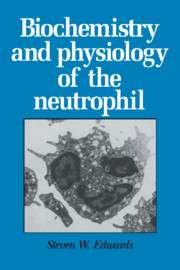Book contents
- Frontmatter
- Contents
- Abbreviations
- Preface
- 1 Neutrophils and host defence: The fight against infection
- 2 The development and structure of mature neutrophils
- 3 The generation and recognition of neutrophil-activating factors: Structure and function of neutrophil receptors
- 4 The cytoskeleton: The molecular framework regulating cell shape and the traffic of intracellular components
- 5 The respiratory burst: The generation of reactive oxygen metabolites and their role in microbial killing
- 6 Neutrophil activation: The production of intracellular signalling molecules
- 7 Neutrophil priming: Regulation of neutrophil function during inflammatory activation
- 8 Disorders of neutrophil function
- Index
7 - Neutrophil priming: Regulation of neutrophil function during inflammatory activation
Published online by Cambridge University Press: 26 February 2010
- Frontmatter
- Contents
- Abbreviations
- Preface
- 1 Neutrophils and host defence: The fight against infection
- 2 The development and structure of mature neutrophils
- 3 The generation and recognition of neutrophil-activating factors: Structure and function of neutrophil receptors
- 4 The cytoskeleton: The molecular framework regulating cell shape and the traffic of intracellular components
- 5 The respiratory burst: The generation of reactive oxygen metabolites and their role in microbial killing
- 6 Neutrophil activation: The production of intracellular signalling molecules
- 7 Neutrophil priming: Regulation of neutrophil function during inflammatory activation
- 8 Disorders of neutrophil function
- Index
Summary
Background
By the late 1970s, the idea that mature, bloodstream neutrophils were terminally differentiated, end-of-line cells was being questioned. In a series of experiments by McCall and colleagues (1973, 1979), the biochemical properties of ‘toxic’ neutrophils – that is, neutrophils isolated from the bloodstream of patients with acute bacterial infections -were characterised. Compared to normal neutrophils isolated from healthy controls, these ‘toxic’ neutrophils exhibited increased oxidative metabolism, phagocytosis, chemotaxis and 2-deoxyglucose transport. They also had increased cellular levels of alkaline phosphatase and showed toxic granulation. Two possibilities could account for these enhanced functions: either the bacterial infection caused the release from the bone marrow of a more active neutrophil population, or the infection somehow changed the activity of the circulating cells. If the latter explanation was the case, then the concept that neutrophils were terminally differentiated was probably incorrect.
At around this time, the synthetic formylated oligopeptides, thought to be analogous to bacterial-derived products, were being characterised. Remarkably, it was shown that the pretreatment of normal neutrophils in vitro with 2 × 10−8 M fMet-Leu-Phe for 15 min could alter the function of these cells so that they resembled ‘toxic’ neutrophils. The conclusion, therefore, was that factors induced by the bacterial infection (either derived from the bacteria themselves or else generated by the host in response to the infection) could up-regulate the function of mature, circulating neutrophils.
It was later shown that substimulatory concentrations of many types of neutrophil agonists could also induce this up-regulation of function. Because the concentrations of these compounds that were required did not activate the neutrophil per se, the phenomenon was referred to as ‘priming’.
- Type
- Chapter
- Information
- Biochemistry and Physiology of the Neutrophil , pp. 235 - 262Publisher: Cambridge University PressPrint publication year: 1994
- 2
- Cited by



